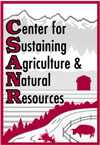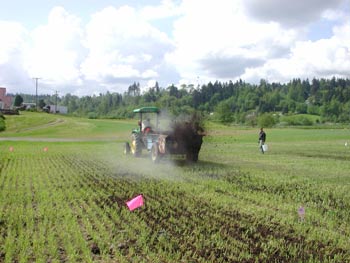Overview:
WSU Puyallup has 12 acres of certified organic farming research land and several more acres of non certified land that has been managed organically. Current and past experiments include the Organic Farming Systems experiment, cover crop trials, climate change gas experiments, food safety, pastured poultry, and improving no till and minimum tillage methods.
Research areas:
In 2002 we began the Organic Farming Systems experiment, an integrated research program focused on sustainable and organic production systems for small-scale, direct-market vegetable crop production. Our goal is to work with farmers to develop management systems that utilize local inputs to produce high-quality, high-value crops efficiently and profitably in an environmentally sustainable manner.
Using locally available organic materials (manures, yard wastes, etc) reduces nutrient imbalances and improves soil productivity. Information on managing such materials including nutrient availability, equipment compatibility, potential side effects, economics.
We have been working with winter and summer cover crops to find varieties most effective at reducing weeds in later crops. Cover crops reduce erosion, improve soil structure, and provide organic matter and nitrogen to the soil. Research results and photo essays.
We measured soil physical and biological properties in a variety of crop and management organic farming systems to see how they affected the soil quality over time. Looked at were soil texture, bulk density, nitrogen, organic matter, microorganisms, and their relationships.
We raised slow and fast growing Cornish Cross poultry in our Organic Farming Systems plots. They provided nutrients to the soil for the vegetables grown during the cash crop part of the pasture/crop rotation, as well as income during the pasture part of the rotation. Included are moveable cage plans and comparisons of the different Cornish Cross varieties.
Online PDF Summary of three focus groups with organic and conventional Western Washington Farmers held in 2002. The objective of a focus group is not to reach consensus or make decisions, but to simply gain the greatest possible understanding of the topic from the perspective of all participants. Topics included Soil Fertility, Cover Crops, Soil Testing, Stream Bank Management and Water Quality.

Slideshows, Photos, and Webinars:
♣ Photo Gallery from certified organic research land (HTML-Online)
♣ Soils and Fertilizer (72 slides, PDF-Online, use browser down scrollbar to advance slides). Soil physical properties, fertilizers, soil amendments, cover crops.
♣ Introduction to Summer Cover Crops (16 slides, PDF-Online, use browser down scrollbar to advance slides)
♣ Closing the Recycling Loop Through Organic Amendments in Agriculture and Gardens (Webinar-Online, Original broadcast date 5 Jan 2011. Slow loading, please wait till after “check our troubleshooting…” goes away. Needs Flash Player to run which is not available on Apple products).

Current & Past Project Support:
♣ USDA Integrated Organic Program CSREES
♣ WSU Center for Sustaining Agriculture and Natural Resource Organic Program
♣ Western Region SARE Grants No. GW06-011, SW03-040
♣ USDA IFAFS Grant No. 2001-52101-11349



Links:
♣ WSU Center for Sustaining Agriculture and Natural Resources, information, publications, links, events, programs.
♣ Cultivating Success, sustainable small farm information for Washington and Idaho.
♣ Food Systems (integrates former Small Farms), information, calendar, resources, programs.
♣ Oregon State University Cover Crops Bulletins, A series of bulletins that describes the uses and management cover crops grown in the Pacific Northwest
♣ Managing Cover Crops Profitably, 3rd ed., Free ebook download or purchase hardcopy. Published by USDA Sustainable Agriculture Network. This publication summarizes research data and farmer evaluations of cover crops grown across the United States.
♣ University of California Sustainable Agriculture Research and Education Program Cover Crop Resource Page
♣ Nutrient Management Guide: Sweet Corn (PDF-Online). For both conventional and organic growers.
♣ Nutrient Management Guide: Silage Corn (PDF-Online).

Publications:
♣ Soil Physical Properties, Nitrogen, and Crop Yield in Organic Vegetable Production Systems (PDF-Online). Cogger. C.G., A.I. Bary, E.A. Myhre, A. Fortuna, and D.P. Collins. 2016. Agron. J. 108:1142-1154. doi:12.2134agronj2015.0335
♣ Potential Carbon Sequestration and Nitrogen Cycling in Long-Term Organic Management Systems (PDF-Online). Bhowmik, A. Fortuna, L.J. Cihacek, A.I. Bary, P.M Carr, and C.G. Cogger. 2016. Renewable Agric Food Sys. doi:10.1017/S1742170516000429
♣ Use of Biological Indicators of Soil Health to Estimate Reactive Nitrogen Dynamics in Long-Term Organic Vegetable and Pasture Systems (PDF-Online). Bhowmik, A. Fortuna, L.J. Cihacek, A.I. Bary, and C.G. Cogger. 2016. Soil Biol. Biochem. 103:308-319.
♣ Influence of Seeding Ratio, Planting Date, and Termination Date on Rye-Hairy Vetch Cover Crop Mixture Performance Under Organic Management (PDF-Online). Lawson A., C. Cogger, A.Bary, A. Fortuna. 2015. PLoS ONE 10(6): e0129597. doi:10.1371/journal.pone.0129597
♣ Cover Crop Effects on Light, Nitrogen, and Weeds in Organic Reduced Tillage (PDF-Online). Wayman, S., C.G Cogger., C. Benedict, D.P. Collins, I Burke, and A.I Bary. 2015. Agroecology and Sustainable Food Systems, 39:647-665. doi: 10.1080/21683565.2015.1018398
♣ The Influence of Cover Crop Variety, Termination Timing, and Termination Method on Mulch, Weed Cover, and Soil Nitrate in Reduced-Tillage Organic Systems (Request pdf e-copy). Wayman, S., C. Cogger, C. Benedict, I. Burke, D. Collins, and A. Bary. 2014. Renewable Agric Food Sys. doi:10.1017/S1742170514000246
♣ Soil Fertility in Organic Systems – A Guide for Gardeners and Small Acreage Farmers (Request pdf e-copy). Collins, D. C. Miles, C. Cogger, and R. Koenig. 2013. Pacific Northwest Extension Publication PNW 646.
♣ Nitrogen Contribution of Rye-Hairy Vetch Cover Crop Mixtures to Organically Grown Sweet Corn (Request pdf e-copy). Lawson, A., A. M. Fortuna, C.G. Cogger, A.I. Bary, and T. Stubbs. 2012. Renew. Ag. Food Sys. 28:59-69. Available on CJO doi:10.1017/S1742170512000014.
♣ Farm-Scale Variation of Soil Quality Indices and Association with Edaphic Properties (Request pdf e-copy). Collins, D.P., C.G. Cogger, A.C. Kennedy, T. Forge, H.P. Collins, A.I. Bary, and R. Rossi. 2011. Soil Sci. Soc. Am. J. 75:580-590.
♣ Management Effects on Soil Quality in Organic Vegetable Systems in Western Washington (Request pdf e-copy). Pritchett, K., A.C. Kennedy, and C.G. Cogger. 2011. Soil Sci. Soc. Am. J. 75:605-615.
♣ Nutrient Management Guide: Sweet Corn (Western Oregon) (PDF-Online). For both conventional and organic growers. Hart, J.M, D.M. Sullivan, J.R. Myers, and R.E. Peachey. 2010. Oregon State University Extension Service. EM9010-E.
♣ Nutrient Management Guide: Silage Corn (Western Oregon) (PDF-Online) For both conventional and organic growers. Hart, J.M., D.M. Sullivan, M. Gamroth, T. Downing, and A. Peters. 2009. Oregon State University Extension Service. EM8978-E.
♣ Estimating Plant-Available Nitrogen Release from Manures, Composts, and Specialty Products (Request pdf e-copy). Gale, E.S., D.M. Sullivan, C.G. Cogger, A.I. Bary, D.D. Hemphill, and E.A. Myhre. 2006. J. Environ. Qual. 35:2321-2332.
♣ Fertilizing with Manure and Other Organic Amendments (PDF-Online). Bary, A., C. Cogger, and D.M. Sullivan. 2016. PNW0533. Washington State University Cooperative Extension, Oregon State University Cooperative Extension System, US Department of Agriculture.
♣ Fertilizing Farmland with Yard Trimmings from Landscape Maintenance (PDF-Online). Bary, A.I., C.G. Cogger, and D.M. Sullivan. 2016. FS222E. Washington State University Extension.
♣ Soil Management for Small Farms (PDF-Online). Cogger, C.G. 2000. EB 1895. Washington State University Cooperative Extension, Oregon State University Extension Service, University of Idaho Cooperative Extension System, US Department of Agriculture.











































